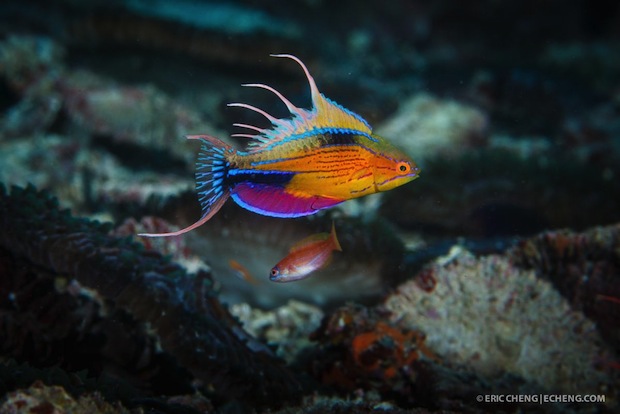The West Papuan endemic Paracheilinus nursalim is not only the crème de la crème of Paracheilinus, it is also one of the newer members to be described; Discovered not too long ago in 2006, and described in 2008. This stunning gem is found only around the rubble substrates of Bird’s Head Peninsula and Triton Bay, far out of reach for would be collectors. For this reason, few pictures of P. nursalim exists and zero specimens have entered the hobby.

Typically for Paracheilinus, males are reddish-yellow in their unexcited state. It is only when the males are excited during territorial displays or courtship that they start “flashing” their nuptial colours. Flashing males of this species are particularly gorgeous and these photos by Eric Cheng are the best we’ve seen of them in the wild. In full nuptial display, the male takes on a golden hue and reveals two horizontal black bands, one placed on the anterior dorsal region, and another placed just above the anal fin before the caudal peduncle. The 4-6 dorsal filaments and its highly emarginate tail takes on a pale blue-white coloration, while the anal and ventral fins are magenta shot.

Not much is known on the biology of Paracheilinus nursalim, but its behaviour and form corresponds closely to others in the genus. Like other Paracheilinus, P. nursalim is haremic with females greatly outnumbering males. The females are a plain reddish-orange without any exaggerated filaments. All Paracheilinus are protogynous hermaphrodites and in a social setting where the dominant male is removed, the largest and most aggressive female will change its sex to take its place.

As mentioned above, the flasher wrasses are most beautiful in their nuptial and excited coloration. Displays usually take place when a male is sparring against another male of its kind or another species, or when males are vying for attention during breeding. In a potential event for procreation, males first identify suitable females which are gravid and receptive for spawning. The following events where nuptial display occurs provides the underwater photographer the best chance for a picture, where males are at their most colourful.
Colour change from their unexcited state to full blown display takes only seconds, and the males swim very quickly around the females with intermittent fin flaring. Photographing a flashing Paracheilinus or Cirrhilabrus during full display is not an easy task. It is with much skill and patience that Eric Cheng manages to score these gorgeous pictures of a fish so seldom seen. For more spectacular underwater photos, visit his website here.



